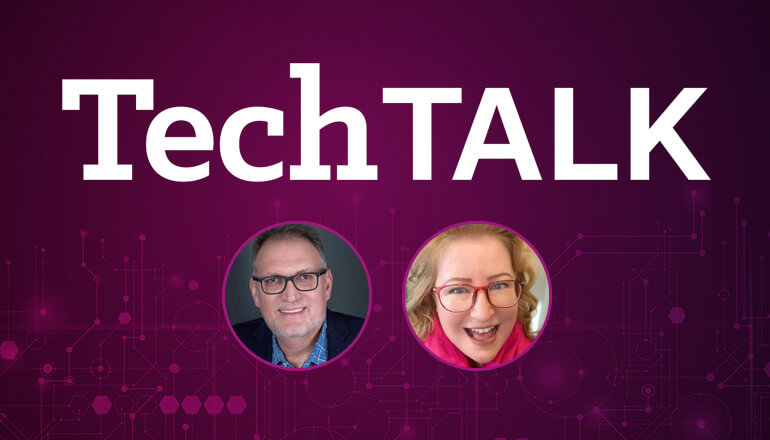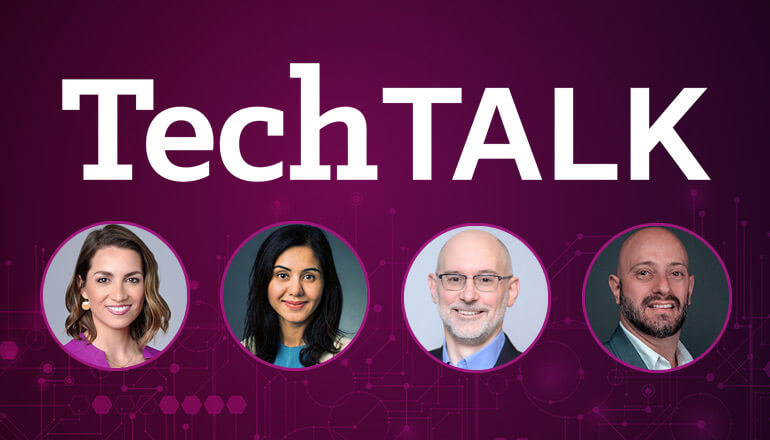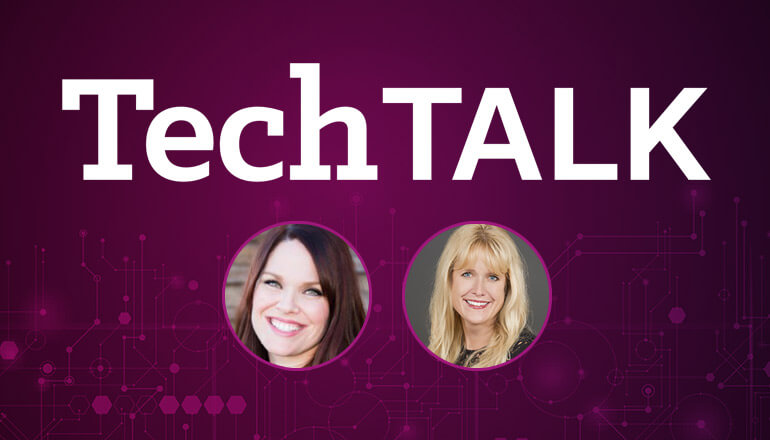Audio transcript:
How a Strong Data Intelligence Program Drives New Business Outcomes
Erin
Hello and welcome to today's Tech Talk. My name is Erin Hazen, your Tech Talk host and Client Solutions Executive here at Insight. I am sincerely looking forward to today's episode where we will discuss the value of a strong data intelligence program. It is my pleasure to introduce today's guest speaker, Sue Laine, Director of Solutions Strategists for Quest's Erwin Data Modeler and data intelligence solutions. Sue directs the global team and is a thought leader in the data intelligence space. Prior to joining Quest, Sue has over 15 years of experience working for ASG Technologies and seven years implementing metadata and data governance for Wells Fargo. Welcome Sue, and thank you so much for joining us today.
Sue
Thank you, Erin. It's really nice to be here.
Erin
Great. So let's set the scene for the audience a little bit. What is data intelligence? Who's doing it? What does it look like and what is the business outcome of a strong data intelligence program? We know that clients are finding new intelligence ways for increasing the value of their data. So today we're going to talk about what automation and business collaboration can do to raise the value of data inside any organization. Sound good?
Sue
Sounds great.
Erin
So let's start with the basics, Sue. Today we're talking about data intelligence. When we talk about data intelligence what does that mean?
Sue
A lot of people have been asking me that now because it's really grown over the years to incorporate a lot more automation and things like that, but let me just start with, you know, just some of the basics that it started with data governance and it started with understanding the metadata so the information around the data and then grew into this data intelligence realm. And I like to describe it kind of in that data maturity pyramid where data is the foundation of everything that you do. But if you just get a dump of data, all you get is a bunch of numbers.
Erin
Right.
Sue
So the second rung on that pyramid is actually the information section. So in order to really understand that data, you need information. And that information is usually in the form of a catalog or in the form of a metadata repository, and it's all that schema type information about the data, and then the next step on that pyramid is knowledge. So you go from data to information to knowledge about that data. And that piece is really where you really start to apply some business context and you start to think of data through the lens of the business and you start to make a lot of connections from business to the data. And that is typically done with an data intelligence environment. So a data intelligence environment or platform usually has capabilities like data lineage, like reference data management, and it also connects and rationalizes business information to technical information, so that you start to understand what business process, what business policy has what type of data and where do I go to find that data about GDPR about my customer. So that's data intelligence. And then the top of the pyramid is always wisdom. And wisdom means, that you're at the point where you're achieving some great insights and I like to explain insights as a change to the perception of your reality. So if you're going to trust that change of perception to your reality, you have to trust the data and everything kind of leads up to trusting the data.
Erin
I love this. And I guess maybe the follow up question would be for you would be what is the customer problem we're trying to solve? I think I know the answer, like taking messy, messy lumps of information and making it easier to dive into, but please explain to us in your words like what are customers looking to to figure out here.
Sue
The customers are looking to figure out, to be honest, most customers still have a hard time finding the data that they need. So if you're about to embark on a new campaign within the organization or a new initiative within the organization, they're having trouble finding where all their good, solid customer data is. They're having trouble understanding the data, comparing the data, there's a lot of data bloat out there. So the customers are trying to use data effectively and efficiently and understand that data. That's primarily what they're trying to do with a data intelligence environment.
Erin
Great, no, that's an excellent explanation and maybe just a little bit more clarity if you don't mind, around the difference between data governance and data intelligence.
Sue
Yeah, data governance, think of that as the structure to managing your data. And there's a lot of workflows behind the scenes. A lot of data owners, a lot of data stewards that are out there curating the data and ensuring that they're owning the data and they're defining the data as it's seen through the eyes of the business. Data intelligence is more about turning that data into insights about taking action on the data and having that transparency every day at your fingertips so that you can actually do something with that data.
Erin
I love this. I love that you are able to, with this solution, take something that probably, like you said, is super overwhelming and difficult to even just parse out the information that you think you're looking for before you even try and leverage that in a beneficial way. So this is a hugely valuable solution. Can you tell us where you see most clients and where they are in this journey today? I think you kind of touched on that a little bit but maybe elaborate if you don't mind.
Sue
Yes, no problem. So I've been doing this for quite some time and I've seen how it's evolved to where we are today. And most clients have already started some sort of data governance initiative and they've probably dipped their toe into some sort of data intelligence initiative but they're having trouble connecting the dots, they're having trouble, they're falling short of the end result of finding my data quickly, knowing how to use it, knowing where it came from and knowing how it's described. So as a vendor, they're coming to us saying, hey, I have this business glossary, I can govern this information, not having a whole lot of success. It's really political and I need to really get into the underpinnings of the organization of actually impacting the data, of changing the data, of maturing the data, of increasing the quality of the data. So that's where most clients, I think, they're brave, they're strong, they know they need to do it but they're having trouble doing it.
Erin
And you led up to my follow up question there which is how is Quest helping make sure that clients are successful with that?
Sue
So, Quest has been in the data management industry for quite some time starting with their best of breed data modeling technology which is Erwin Data Modeler. And so they've been in this industry modeling out the data with the data architects of the organization for quite some time and just in the last couple of years they've created a data intelligence environment and they've connected the two together so that you can accelerate and bring in all of that great data that the architects have been working on for so long and start to define the information that the client is seeing in the data environment with the data modeling information. So instead of starting with a blank slate of here's a empty business glossary and you start to scan all the different schemas of your applications to get your arms around that, you're actually starting with understanding your critical data, understanding how it's logically defined, how it's logically moving through the different systems and then you're showing how it's represented inside of a database itself. Did that make sense? Okay.
Erin
Totally makes sense, and my understanding is that you guys have created a really usable interface for end users because we talked about this a little bit before how if something isn't easily findable, we probably won't look for it too hard, right?
Sue
Yes. So that, it's really basic, but it's a strong point. I've seen a lot of implementations fail because the end users just give up on it and say, "Why am I doing this? "It doesn't make sense and it's not easy to use "and I don't want anything to do with it." So yes, Quest, a little bit less than a year ago came out with 12.0 which was a reboot on the entire user interface, and they came out with some new capabilities as well as a brand-new user interface because they understood the challenge from a business perspective. So there's a lot of really user friendly Amazon-like features that you can categorize information with and you can see those categories as you're searching, as you're trying to find the information and then a lot of collaboration within the tool amongst the business users themselves. So there's things like an action center where you can go and request the data and just send in a ticket to get that data. You can compare data. Just a lot of really neat, new end user features.
Erin
I love this. So really, literally, if you build it they will come and they wouldn't-
Sue
Yes. Sure hope so.
Erin
I love that, Sue. So tell me a little bit about what does success look like with a strong data intelligence program?
Sue
Yeah, so in my time with working with really large organizations, I've seen clients really drill through a lot of data bloat. So as an example, I had an insurance client that went from 265 client ID numbers down to 12. And that was real success for them. I've seen clients that were trying to rationalize critical data elements and for just 10 data elements, it was taking them six months to just understand what are my critical data elements and what are everything impacted by this critical data element, whether it's business or technical. And they've gone from that six months down to just a couple of hours to be able to load and perform that data impact analysis with a data intelligence technology. And then just very recently, I had the really great pleasure of watching one of our clients Romina (indistinct), who is from E.ON, it's one of the largest energy companies over there in Europe. She was presenting about her team and her program which is called DARE, D-A-R-E, which stands for data readiness. And their goal was really to deploy data across all their different business lines which crossed many country borders in itself. And they're really focusing on growing, sustaining, and digitizing the information with their data across the organization. And she was just a fabulous, they have over 500 users, they have an annual evangelist user participation group that grew from 50 clients to over 2000 clients that come out for it. And they're just moving fast and furiously across those different countries at E.ON supporting data with their data intelligence environment.
Erin
I love it. I love that you can clearly see as soon as you have the access and the capability, how quickly that can transform a business clearly from your experience there. So, so tell me one more thing, before we close for today, which is what do you see coming in the near future for data intelligence and what do we have to look forward to seeing from Quest?
Sue
Right. So one of the things that I'm really excited about though there's a couple and it's really becoming clear that the art of the possible is really starting to happen through technologies like we do at Erwin by Quest. One of the capabilities that's really interesting is the new marketplace. So a marketplace is somewhere where an end user can go and shop and share information. So really, really amping up that user interface so that clients can shop for information, shop for data, share it, do Amazon compares, and really try to figure out which is the correct data set that I need to use to solve this business challenge, and then just a lot of trust features on that so that you can start to understand and score the data and see the scores in a powerful lineage diagram. So if you're looking at the flow of the data, you can see that, okay, here's one that I can trust because it has a score of 90% and I can see that it's propagating into this pipeline of data that I have to track and manage on a regular basis, so I know it's good and true, really working on increasing the reliability of the data and the data uptime, if you will. Another really cool new program has everything to do with the data mesh. So, you're going to see a lot of that coming out. Gartner, I think was the first to kind of propose the data mesh, and that's really going to make this metadata available at your fingertips at every system that you're in. It's just going to come along with the system and we're going to work more in a decentralized versus a centralized mode. And I think that's really going to further what we're doing in the land of data intelligence.
Erin
I love it, Sue, this is so interesting and I'm super excited to see how this continues to evolve and transform with the Erwin by Quest solution. So thank you so much for your time today. We sincerely appreciate you sharing your expertise and knowledge with us and for teaching us all about data intelligence and how Erwin by Quests can help organizations make a better and more valuable use of their data. And thank you for joining us today. If you'd like to learn more about Insight Solutions be sure to visit insight.com. And while you're there, make sure you sign up for our quarterly digital magazine, "The Tech Journal" for even more inspiration and insights around the future of business and technology. And for more information about data intelligence and Erwin by Quest solutions, make sure you check out today's show notes. Once again, my name is Erin Hazen and on behalf of Insight, we are so grateful for your time and attention today. I look forward to sharing a Tech Talk again with you soon. Have a fabulous day.
Sue
Thank you, Erin. My pleasure.
Erin
Thank you.










